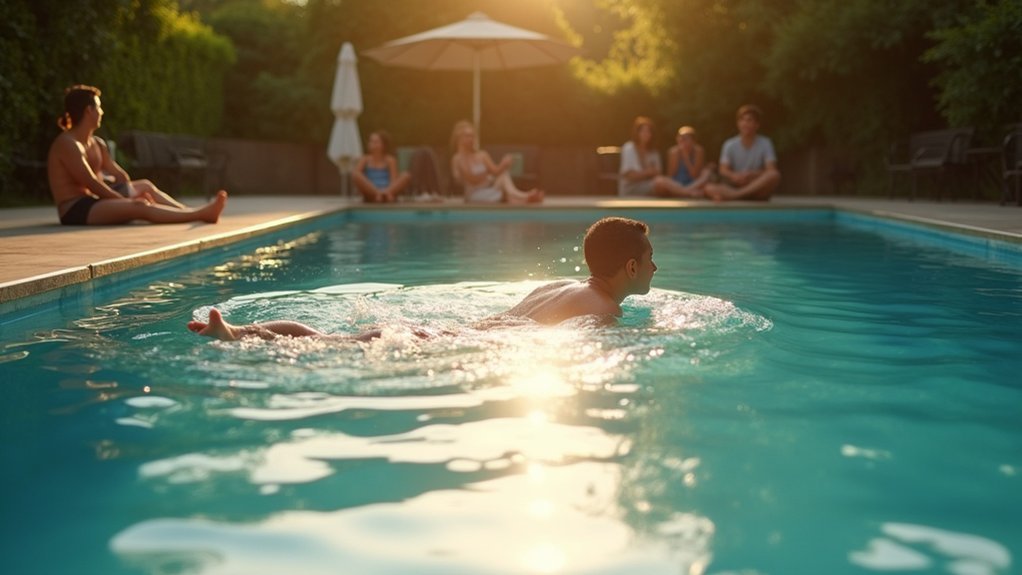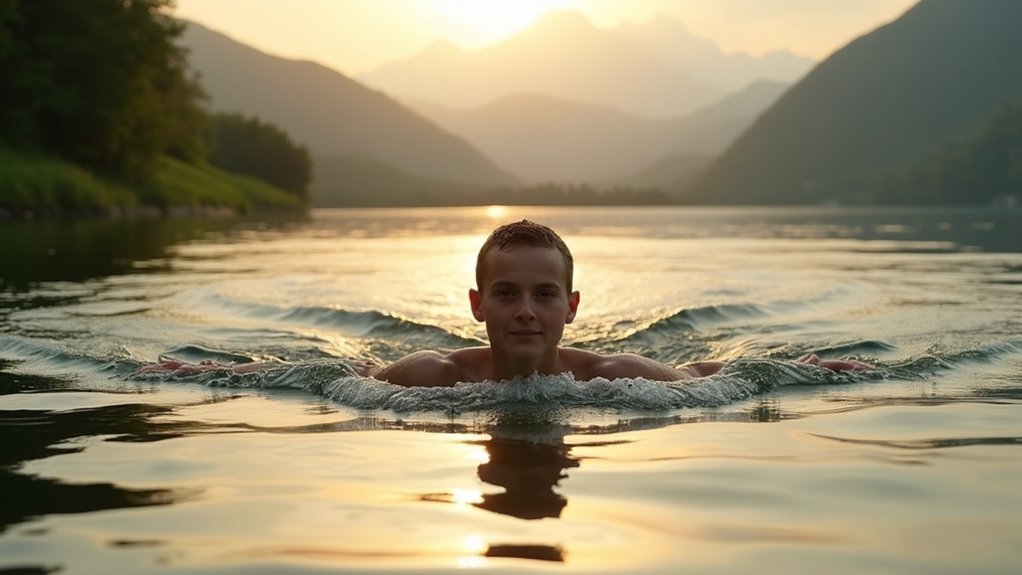Swimming offers remarkable healing for PTSD by combining physical activity with water’s unique therapeutic properties. You’ll experience reduced stress hormones and increased endorphins while the hydrostatic pressure creates a protective sensory boundary. The water environment helps regulate breathing, promotes mindfulness, and reduces hypervigilance. Many veterans report significant improvements in both physical symptoms and mental well-being. Community-based aquatic programs provide connection and support that traditional therapy alone can’t match.
Understanding PTSD and the Science of Aquatic Healing

While trauma affects everyone differently, Post-Traumatic Stress Disorder (PTSD) represents a particularly challenging mental health condition that impacts approximately 3.6% to 6% of American adults. It develops in about 20% of those who experience trauma, manifesting through symptoms like flashbacks, avoidance behaviors, mood changes, and heightened reactivity. Women experience twice the prevalence rate of PTSD compared to men, with 8% of women developing the condition in their lifetime.
The science behind aquatic therapy offers promising relief. When you swim, your brain increases blood flow, improving cognitive function while releasing endorphins that naturally combat stress and anxiety.
Water provides a unique therapeutic environment that helps regulate sensory processing and emotional responses. Swimming’s physiological benefits—cardiovascular strengthening, pain reduction, and muscle relaxation—work alongside psychological improvements in self-concept and confidence, making it an ideal holistic approach for PTSD recovery.
How Water Creates a Safe Space for Trauma Recovery
When you’re immersed in water, your nervous system receives filtered sensory input that naturally shields you from overwhelming stimuli that might trigger PTSD symptoms.
The water’s embrace creates a protective boundary between your body and the outside world, allowing you to focus on present sensations rather than traumatic memories.
You can enhance this protective effect through mindful floating practice, where you concentrate on the gentle support of the water while practicing controlled breathing techniques. The warm water temperature closely matches your body’s own heat, creating an environment that promotes deep relaxation and comfort during therapy sessions.
Protective Sensory Environment
For individuals battling PTSD, water offers a uniquely protective sensory sanctuary unlike any land-based therapy environment. When you’re immersed in water, the hydrostatic pressure naturally releases calming neurochemicals while simultaneously blocking overwhelming external stimuli that often trigger anxiety.
You’ll find that water’s buoyancy creates a weightless sensation that reduces physical tension and joint pain. This environment enables you to practice controlled breathing techniques vital for managing panic attacks. The pressure surrounding your body provides a gentle, constant touch that many find deeply grounding during moments of sensory overload. Wild swimming in natural bodies of water can provide a more private and tranquil setting for this therapeutic experience, allowing individuals to avoid the potential anxiety triggers of traditional swimming environments.
Swimming pools offer controlled settings where you can monitor your surroundings, fostering a sense of safety essential for trauma recovery. In water, you’re embraced by an element that simultaneously calms your nervous system and creates boundaries between you and potential triggers.
Mindful Floating Practice
Within the healing journey of PTSD, mindful floating emerges as a powerful therapeutic practice that builds upon water’s protective sensory benefits.
You’ll experience deep relaxation as you float, greatly reducing anxiety and stress—common PTSD symptoms that often feel overwhelming.
The quiet environment naturally encourages introspection, helping you process difficult emotions while fostering mindfulness that extends beyond your time in the water. This practice can dramatically improve your sleep quality, essential for your ongoing recovery.
What makes floating particularly effective is how it complements traditional therapies like CBT. By creating a receptive mental state, you’ll likely find your other treatment modalities become more effective. The sensory-free environment created during floatation therapy allows individuals with PTSD to escape overwhelming stimuli that often trigger symptoms.
Your body responds neurobiologically with reduced cortisol levels, increased feelings of happiness, and enhanced emotional control.
The Mind-Body Connection in Aquatic Therapy

The mind-body connection forms the foundation of aquatic therapy’s effectiveness for PTSD treatment. When you enter the water, you’re engaging both physical and neurological systems simultaneously. The buoyancy reduces physical stress while hydrostatic pressure increases blood flow, creating ideal conditions for healing.
As you swim, your brain releases endorphins while stimulating hippocampal neurogenesis—literally rebuilding brain structures damaged by trauma. You’ll notice improved mood stability as water-based activities enhance serotonin and dopamine activity. Water submersion also decreases swelling and reduces blood pressure, providing physical relief that supports psychological healing.
This integration happens naturally; each stroke strengthens muscles while promoting neuroplasticity. The sensory experience of water encourages mindfulness, bringing you into the present moment.
Water’s unique properties create an environment where physical healing directly supports psychological recovery, making aquatic therapy particularly valuable for addressing the complex symptoms of PTSD.
Veterans’ Success Stories: Transformations Through Swimming
Veterans across the country have discovered powerful healing through aquatic environments, turning their personal battles with PTSD into stories of remarkable transformation.
You’ll find these success stories highlight both physical and psychological benefits that swimming uniquely provides. Many veterans report significant improvements in muscle strength, joint flexibility, and pain management while experiencing reduced anxiety and better sleep patterns. Therapists often incorporate underwater treadmills to enhance these physical benefits while minimizing joint stress.
The water’s therapeutic properties create a safe space where you can rebuild confidence and develop effective stress coping mechanisms.
What makes these transformations truly powerful is the community aspect. Swimming programs connect veterans with peers who understand their struggles, creating support networks that extend beyond the pool.
Through these connections, you’ll see veterans regaining independence, building resilience, and redefining what they believe possible in their recovery journey.
Getting Started: Finding the Right Aquatic Program for Your Needs

Finding the right aquatic program can feel overwhelming when you’re first exploring swimming as a PTSD treatment option.
Taking that first step toward aquatic healing often feels like diving into uncharted waters.
Start by identifying facilities that offer specialized aquatic therapy with trained practitioners and heated pools, which greatly enhance the therapeutic experience. Consider facilities with practitioners who have completed 1,000 hours of training in both aquatic and massage therapy techniques.
When selecting a program, consider these key factors:
- Cost and accessibility – many community centers offer affordable options with flexible scheduling to accommodate your lifestyle
- Program customization – look for services that tailor activities to your specific needs and skill level
- Support components – the best programs include breathing techniques, buoyancy support, and mental health resources
Don’t hesitate to ask about warm water therapy options, as water at body temperature helps reduce PTSD symptoms through enhanced relaxation.
Most facilities welcome inquiries and often offer trial sessions.
Overcoming Water-Related Anxieties and Building Confidence
Water-related anxieties can create significant barriers for those exploring swimming as a PTSD treatment option. These fears often stem from past traumatic experiences but can be overcome through progressive exposure and mindfulness techniques. Many victims of Camp Lejeune contamination have reported water-related anxiety as part of their psychological trauma.
| Anxiety Type | Challenge | Effective Technique |
|---|---|---|
| General Fear | Hesitation to enter water | Progressive exposure |
| Breath Control | Panic during submersion | Controlled breathing exercises |
| Flashbacks | Trauma triggers in water | Mindfulness practices |
| Social Anxiety | Discomfort in public pools | Supportive group programs |
| Fear of Depth | Panic in deeper water | Gradual depth progression |
You’ll find that building confidence happens gradually. Start with shallow water exercises while practicing breath control. As you develop skills and experience the endorphin release, your self-efficacy will grow. Remember that trained therapists can provide essential support during this journey, helping you rebuild your relationship with water and transform it into a healing environment.
The Physiological Benefits of Hydrotherapy for PTSD Symptoms

Your body responds physiologically to water immersion by reducing cortisol levels, which directly counters the heightened stress response so common in PTSD.
When you swim or engage in water therapy, your nervous system activates pain-relief pathways through increased endorphin production and reduced inflammation from hydrostatic pressure. Water bathing has been shown through medical research to significantly decrease stress hormones and improve serotonin levels, creating a powerful therapeutic effect.
These biological mechanisms work together to restore your neurochemical balance, helping to regulate mood, sleep patterns, and anxiety levels that are typically disrupted in PTSD.
Cortisol Reduction Mechanics
The complex relationship between cortisol and PTSD symptoms creates a unique opportunity for hydrotherapy interventions. When you immerse yourself in water, particularly warm water, your body responds by triggering several physiological mechanisms that naturally reduce cortisol levels. Recent research suggests that low-dose cortisol administration can significantly decrease the intensity and frequency of traumatic memory recall in patients with chronic PTSD.
- Hydrostatic pressure increases blood circulation throughout your body, reducing inflammation and promoting a sense of physical well-being.
- Heat therapy relaxes tense muscles, decreasing anxiety and creating conditions for your stress response to diminish.
- Buoyancy effects allow for gentle movement and exercise without joint strain, encouraging endorphin release.
This cortisol reduction isn’t just temporary—regular hydrotherapy sessions can help normalize your neuroendocrine function over time, potentially creating lasting improvements in your PTSD symptoms through sustained hormonal balance.
Pain-Relief Pathways Explained
Beyond cortisol reduction, hydrotherapy offers significant physical pain relief—a key component for PTSD treatment since many sufferers experience somatic symptoms.
When you’re immersed in water, buoyancy immediately reduces pressure on painful joints and tense muscles, creating a supportive environment for movement without additional stress.
The hydrostatic pressure of water increases your blood circulation, reducing inflammation while promoting healing.
As warm water envelops your body, it provides a natural analgesic effect, calming both your nervous system and aching muscles simultaneously.
This combination creates neurological pathways for pain reduction that extend beyond your time in the pool.
Water’s gentle viscosity allows you to rebuild strength and flexibility gradually, addressing physical manifestations of trauma without triggering additional pain—a critical factor in breaking the cycle of trauma-induced physical distress.
For veterans especially, these therapeutic activities in a pool environment can be customized with individualized programs that address their specific trauma-related physical symptoms.
Neurochemical Balance Restoration
Swimming’s remarkable impact on neurochemical balance lies at the heart of its effectiveness for PTSD treatment.
When you immerse yourself in water, your body begins a natural healing process that directly addresses the neurochemical imbalances common in trauma survivors.
Your brain’s chemistry shifts in several positive ways:
- Cortisol levels decrease considerably during hydrotherapy, reducing your chronic stress response
- Serotonin production increases during water-based activities, improving mood regulation and emotional stability
- Endorphin release during swimming provides natural pain relief and creates feelings of well-being
The hydrostatic pressure and buoyancy of water create ideal conditions for these changes to occur. The viscosity of water provides continuous tactile feedback that helps improve body awareness and sensory integration for trauma survivors.
Regular swimming sessions help maintain these neurochemical improvements over time, making it an effective long-term strategy for managing PTSD symptoms without medication.
Integrating Swimming Into Your Overall Treatment Plan

When developing a thorough treatment approach for PTSD, incorporating swimming can considerably enhance your healing journey.
Consider discussing swimming with your therapist to complement your existing treatment. Regular swimming sessions can amplify the effectiveness of psychotherapy by reducing baseline stress levels before sessions.
You’ll find swimming works well alongside other mind-body practices like yoga, creating a holistic approach to healing.
If you’re taking medication, adding swimming may improve overall treatment efficacy through natural endorphin production.
Start with personalized swim therapy plans that address your specific needs and triggers. Many programs offer adaptive techniques specifically designed for trauma recovery.
Join supportive swimming communities that understand your challenges and provide a safe environment for practice. The rhythmic nature of swimming movements promotes mental clarity and focus, which can help counteract intrusive thoughts common in PTSD.
With professional guidance, you’ll gradually build confidence in various swimming environments.
Adaptive Equipment and Techniques for Various Abilities
Numerous adaptive equipment options and specialized techniques can make swimming accessible for individuals with varying abilities who are managing PTSD.
Whether you’re dealing with physical limitations or anxiety in water environments, specialized tools can enhance your therapeutic experience.
- Buoyancy devices and flotation vests provide stability and support, allowing you to focus on relaxation rather than staying afloat—particularly helpful if you experience panic attacks or flashbacks in the water. The PFD-A vest design is especially beneficial for those who may experience seizures or loss of consciousness during PTSD episodes, as it maintains face-above-water positioning.
- Personalized swimming lessons with instructors trained in trauma-informed approaches can adapt techniques to your specific triggers and comfort level.
- Sensory integration activities in water help reduce stress while enhancing mindfulness, creating a powerful tool for managing PTSD symptoms through the mind-body connection.
These adaptations guarantee swimming’s psychological benefits remain accessible regardless of your physical abilities or trauma history.
Building a Supportive Community Through Group Aquatic Activities
When you participate in group aquatic activities, you’ll find healing connections that transcend verbal therapy as trauma survivors understand each other’s journeys without explanation.
You’re creating a network of support where shared experiences in the water foster a unique safety net that traditional therapy often can’t replicate.
Your recovery strengthens through these communal swimming sessions, as witnessing others’ progress inspires your own healing while reinforcing that you’re never alone in maneuvering PTSD’s challenges. The therapeutic environment promotes self-awareness and interpersonal growth through Aquatic Relational Experiential Therapy approaches that emphasize connection with others.
Group Support Heals Trauma
Within the journey of PTSD recovery, group aquatic activities create powerful healing environments that extend far beyond physical exercise. When you join others in water-based therapy, you’re not just swimming—you’re building connections that directly combat isolation and facilitate collective healing.
The psychological benefits of group aquatic therapy are substantial:
- Your stress response diminishes as you practice controlled exposure in a supportive setting.
- Your parasympathetic nervous system activates during cold water immersion, promoting relaxation.
- Your sense of belonging grows, reducing anxiety and enhancing motivation to continue treatment.
These shared experiences foster sustainable recovery pathways while trained professionals provide tailored guidance for your specific needs. Swim lessons specifically help to build confidence in children who have experienced water-related trauma. The combination of peer support and structured activities creates a foundation for long-term healing and improved quality of life.
Connection Beyond Words
In the domain of PTSD recovery, water creates connections that transcend verbal communication. When you enter the pool with fellow survivors, you’re engaging in a form of dialogue that doesn’t require words. The aquatic environment naturally supports non-verbal expression through movement and body language, offering relief when trauma makes speaking difficult.
You’ll notice how shared achievements in water—mastering a stroke or simply staying afloat—build collective pride. Swimming instructors certified in trauma-informed approaches facilitate these moments, helping you develop stronger social bonds. Even in these brief five-minute sessions, meaningful progress can occur, demonstrating that healing doesn’t always require perfect conditions or extended time commitments.
The sensory experience of water enhances proprioception, reconnecting you with your body after trauma’s disconnecting effects.
Regular attendance strengthens these connections, transforming isolated individuals into a supportive network that extends beyond pool sessions, creating a community where healing happens collectively.
Safety Through Shared Experience
Group aquatic activities create a unique sanctuary where trauma survivors find safety in numbers and shared understanding.
When you join a swimming group, you’re entering a community where others may share similar experiences with PTSD, creating an immediate sense of belonging and acceptance.
Swimming together offers benefits that solo swimming can’t match:
- You’ll experience the comfort of peer encouragement, making it easier to face challenges that might otherwise trigger anxiety
- Your achievements, however small, are celebrated collectively, reinforcing positive progress
- You’ll develop meaningful connections as you communicate both verbally and non-verbally in the water
This shared journey through water creates a protective social network that extends beyond the pool, providing emotional support during your healing process.
Measuring Progress: Tracking Mental Health Improvements Over Time
Tracking your mental health journey while using swimming as a PTSD intervention requires both structured assessment and personal reflection. Standardized tools like PCL-5 and IES-R can objectively measure your PTSD symptoms before, during, and after incorporating swimming into your treatment plan.
Consider using digital platforms that compare your psychometric scores over time, allowing you to visualize improvements. These technologies integrate seamlessly with telehealth options, reducing the administrative burden on your treatment team. Utilizing effective treatment plan software can help establish a disease concept for analyzing your responses to aquatic therapy.
Remember that progress isn’t purely numerical. Work with your clinicians to establish personalized goals specific to your situation. Your improvements might manifest through better sleep, reduced anxiety in water environments, or increased social engagement during group swimming sessions.
Regular feedback discussions with your therapist will help adjust your aquatic therapy approach for best healing.
Frequently Asked Questions
Can I Benefit From Aquatic Therapy if I Don’t Know How to Swim?
Yes, you can benefit from aquatic therapy without swimming skills. You’ll use flotation devices, work in shallow water, and receive therapist support. The focus is on movement exercises that leverage water’s buoyancy, not swimming strokes.
How Does Cold Water Therapy Differ From Warm Water Approaches?
Cold water activates your sympathetic nervous system, boosting energy and stress resilience, while warm water engages your parasympathetic system for relaxation. You’ll need shorter sessions (2-5 minutes) in cold water versus longer warm-water therapies.
Is Insurance Coverage Available for Ptsd-Focused Aquatic Therapy?
You can get insurance coverage for PTSD-focused aquatic therapy through Medicare if it’s medically necessary and prescribed by a qualified provider. Private insurance coverage varies by policy, so you’ll need to verify your specific benefits.
What Qualifications Should I Look for in an Aquatic PTSD Therapist?
Look for therapists with ATRIC or APTA certification, trauma-informed training, and hands-on aquatic experience. They should demonstrate effective communication skills and knowledge of PTSD-specific water techniques. Don’t settle for providers without these essential qualifications.
How Long Until I Might Notice Improvements in My PTSD Symptoms?
You’ll likely notice initial improvements within weeks—reduced stress and better mood. Significant PTSD symptom reduction typically occurs within months of consistent treatment, though your personal timeline depends on trauma severity and individual resilience.
In Summary
As you begin your swimming journey with PTSD, you’ll discover healing that extends beyond the water. You’re not just swimming—you’re reclaiming your life stroke by stroke. Don’t rush the process; progress isn’t always linear. Trust that each time you enter the pool, you’re building resilience and creating new neural pathways. The water will always be there, ready to support your ongoing recovery.





Leave a Reply